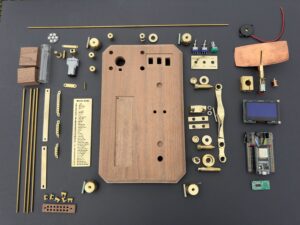
I am fascinated by technology and science and how they affect our lives. As a psychologist, I have always worked at the intersection of complex software and users, developing e-learning systems and designing and realizing user interfaces.
In my art, I try to make complex technology accessible. The Tehuti Brain Scanner from 2024 uses a laser and a crystal ball to show how MRI and CT scanners map the brain layer by layer. The Marconi introduces people to Morse code, for over a century the only way to communicate worldwide. Through a simple game, everyone immediately makes sounds that sound like real Morse code.
As an artist, I am largely self-taught. I was born in Schiedam in 1970 and grew up with a broad interest in physics, electronics, history and the way people interact with each other. Since my first Lego Technic set, I have been fascinated by gears and pistons. What a shame that such objects of complex beauty usually remain hidden. When I was in high school, the Commodore 64 was introduced, the first affordable ‘home computer’. I learned to program on it.
My love for mechanics and electronics was rekindled in 2015 by building the ‘Nautilus’, a Jules Verne-style ‘photo booth’ that allowed guests at my sister’s wedding to take group photos themselves. By combining old techniques – such as electron tubes from the 50s – with modern microcontrollers, the Nautilus amazed people with smoke, light and soap bubbles.

Since then, I have been developing my technical skills, allowing me to work ever more precisely and have more possibilities to shape my ideas. I prefer to use traditional materials such as brass, wood and glass, and combine them with modern electronics. In most projects, writing the underlying software takes considerably more time than creating the mechanical and electronic ‘hardware’.